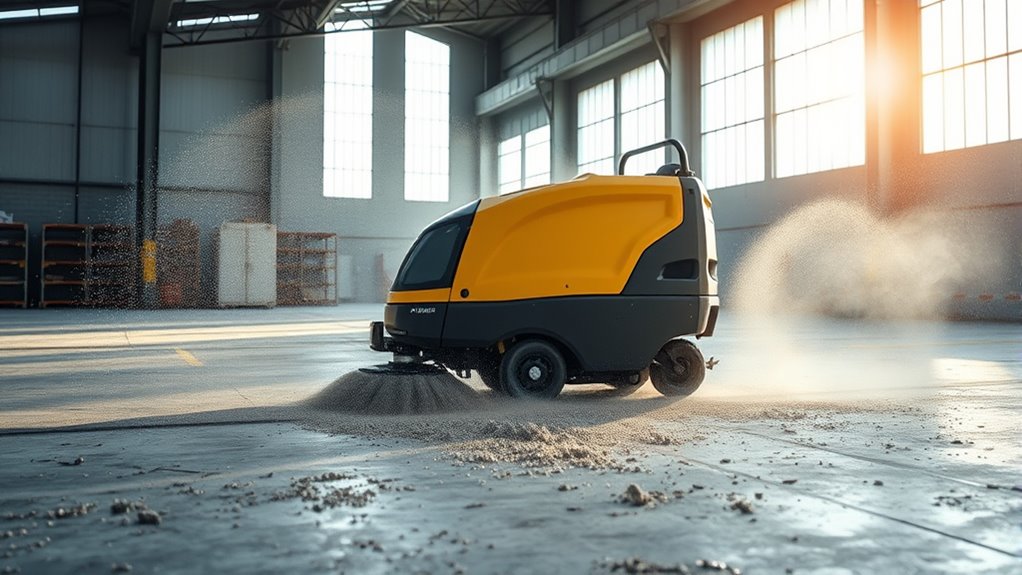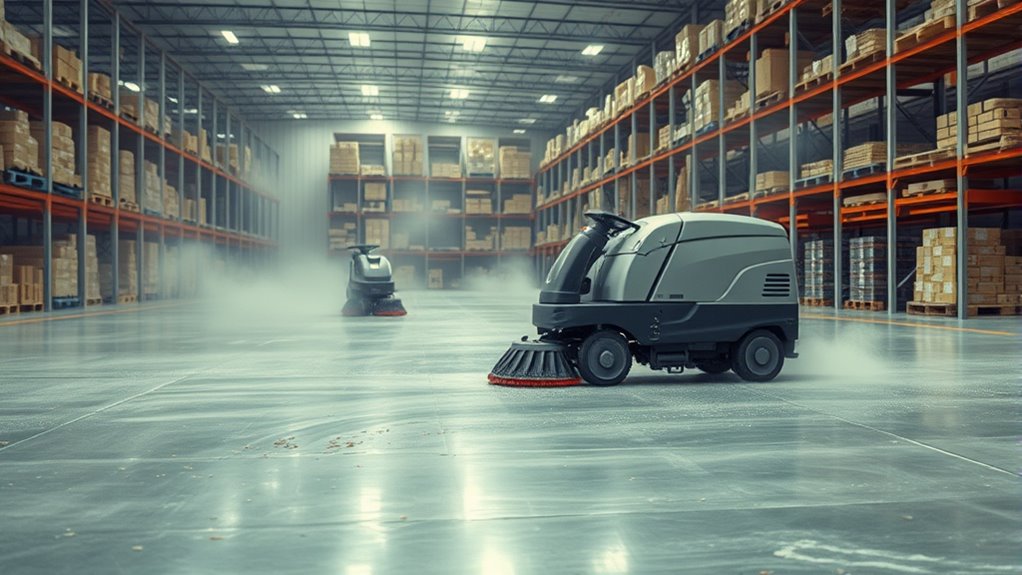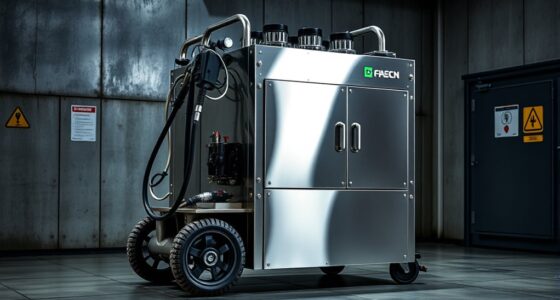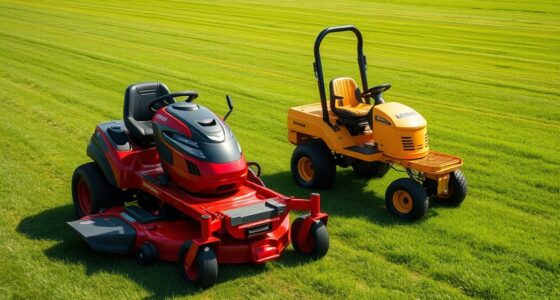Using sweeper-scrubber combos in your warehouse helps you keep dust and debris under control, improving safety and cleanliness. These machines quickly remove dirt, dust, and debris, reducing slip hazards and preventing equipment wear. They also boost efficiency by cleaning large areas in less time than manual methods. Proper dust management protects your staff’s health and extends your equipment’s lifespan. Keep exploring to discover how these tools can transform your warehouse maintenance.
Key Takeaways
- Sweeper-scrubber combos efficiently remove dust and debris, enhancing warehouse cleanliness and safety.
- They combine sweeping and scrubbing in one pass, saving time and improving cleaning thoroughness.
- Regular use prevents machinery wear caused by dust buildup, extending equipment lifespan.
- Suitable for various surfaces, these machines adapt easily to different debris types and warehouse layouts.
- Proactive cleaning with these combos maintains air quality, reduces hazards, and supports seamless operations.

Warehouse dust and debris might seem like minor issues, but they can profoundly impact safety, efficiency, and cleanliness. When dust and debris accumulate, they don’t just make your space look untidy—they also pose real hazards. Dust can get into machinery, causing wear and tear that leads to breakdowns, which means more downtime and costly repairs. Keeping your warehouse clean with effective industrial cleaning practices helps prevent these issues before they start. One of the best tools for this job is a sweeper-scrubber combo, which combines sweeping and scrubbing into a single process, making your cleaning routines more efficient and thorough.
Using a sweeper-scrubber combo ensures that dust and debris are removed from surfaces quickly, reducing the risk of slip-and-fall accidents and improving air quality. Regular use of these machines means less dust dispersal into the air, which benefits your staff’s health and maintains a safer working environment. Plus, these machines are designed to handle large areas efficiently, saving you time and effort compared to manual cleaning methods. They’re especially useful in busy warehouses where debris can accumulate rapidly, and quick, effective cleaning is essential to keep operations running smoothly.
Using a sweeper-scrubber quickly clears surfaces, reducing slip hazards and maintaining a cleaner, safer warehouse environment.
Incorporating a sweeper-scrubber combo into your routine also plays a critical role in maintaining equipment. Dust buildup can clog filters, hinder moving parts, and accelerate equipment wear. By regularly removing dust and debris, you help extend the lifespan of your machinery and reduce costly repairs. This is where consistent industrial cleaning becomes essential. It’s not just about appearance; it’s about protecting your equipment investment and ensuring everything functions at peak performance. Proper equipment maintenance, supported by routine cleaning, prevents small issues from escalating into major failures and keeps your warehouse operations running seamlessly.
Furthermore, a sweeper-scrubber combo can be programmed or operated manually to suit different surfaces and debris types. Whether you’re cleaning concrete floors, epoxy coatings, or textured surfaces, these machines adapt easily, delivering a consistent clean each time. This adaptability minimizes the need for multiple cleaning tools and simplifies your maintenance routine. As a result, you can allocate resources more efficiently and focus on other critical tasks. When dust and debris are managed proactively through industrial cleaning, you create a safer and more productive environment, where both staff and equipment are protected. Robust cleaning technology plays a vital role in enhancing the overall effectiveness of your cleaning routine.
Frequently Asked Questions
How Do Sweeper-Scrubber Combos Handle Wet Versus Dry Debris?
Sweeper-scrubber combos handle wet and dry debris effectively by switching between dry sweeping and wet cleaning modes. For dry debris, you activate the sweeper function to pick up dust and particles. When managing wet debris, you engage the scrubber mode to clean and remove grime or spills. This versatility guarantees thorough debris management across different types of messes, keeping your warehouse clean and safe efficiently.
What Is the Average Lifespan of a Typical Sweeper-Scrubber Machine?
You can expect a typical sweeper-scrubber machine to last about 5 to 10 years, depending on usage, maintenance, and build quality. Its durability influences both its performance and replacement costs, with well-maintained units often lasting longer. Regular upkeep, proper operation, and timely repairs extend its lifespan, helping you maximize your investment and reduce replacement costs over time. Proper care guarantees your machine remains reliable and efficient for years to come.
Are There Eco-Friendly Options Available for Warehouse Cleaning Equipment?
Yes, eco-friendly options are available for your warehouse cleaning needs. You can choose equipment that uses biodegradable cleaning agents, reducing environmental impact. Additionally, look for models that utilize renewable energy options, such as battery-powered or solar-powered machines, to cut down on emissions. These choices help you maintain a cleaner warehouse while supporting sustainability efforts. Switching to eco-friendly equipment is a smart move for both your business and the planet.
How Often Should Maintenance Be Performed on These Cleaning Machines?
You should perform maintenance on your sweeper-scrubber combos regularly, ideally following the manufacturer’s maintenance schedules. Routine checks, cleaning filters, and inspecting belts help prevent breakdowns and guarantee peak performance. Doing so extends machine longevity and keeps your equipment running efficiently. Depending on usage, daily, weekly, and monthly maintenance tasks are essential. Staying consistent with maintenance not only saves money in repairs but also guarantees your cleaning machines work effectively whenever you need them.
Can These Combos Operate Effectively in Tight or Cluttered Spaces?
In tight or cluttered spaces, your sweeper-scrubber combo can still perform effectively. For example, a warehouse manager used a compact model to clean narrow aisles and crowded corners, achieving thorough results without needing multiple machines. These combos are designed with maneuverability in mind, making them ideal for narrow spaces and cluttered environments. With the right attachments and settings, you can easily navigate tight spots and maintain cleanliness efficiently.
Conclusion
So, next time your warehouse turns into a dust tornado, remember those trusty sweeper-scrubber combos. Think of them as your dust-busting superheroes, donning capes made of microfiber and wielding scrub brushes like swords. Without them, you’d be swimming in a sea of debris, looking like a factory floor version of a post-apocalyptic film set. Keep these machines close, and you’ll avoid turning your warehouse into a dusty disaster zone—because nobody wants to work in a sandpit.









